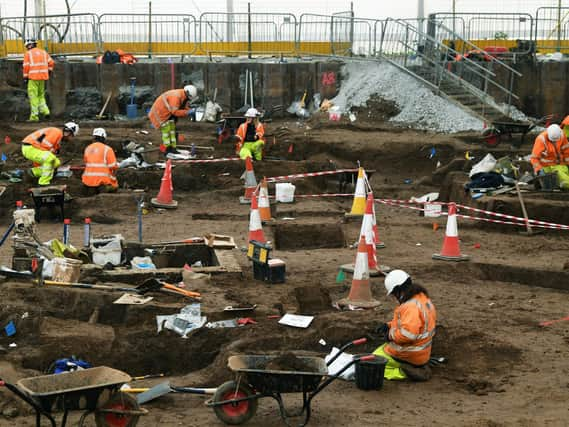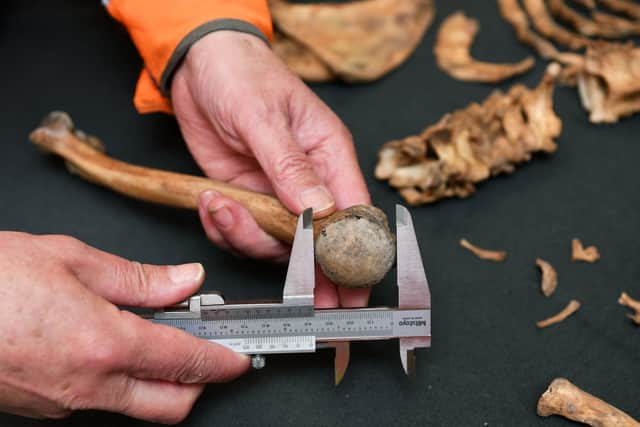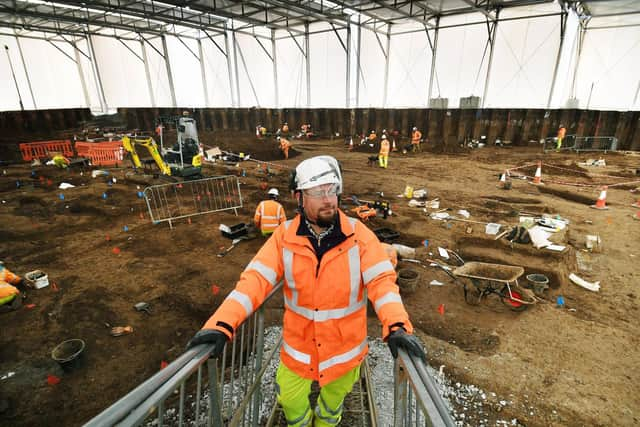Hull excavation uncovers evidence of precautions against bodysnatching in 19th century cemetery


So after 32-year-old engineer William Watkinson died in an accident in April 1835 when the end of a boiler fell on him at the workshop of Hull shipbuilders Brownlow & Pearson, his workmates went to great lengths to ensure his coffin was well protected.
Archaeologists working to clear the city’s Trinity burial ground, as part of Highway England’s £355m upgrade of the A63, have discovered what they believe was his grave a few feet from his headstone, along with the remains of two infants, who were probably his children.
Advertisement
Hide AdAdvertisement
Hide AdA plate from the boiler had been inserted into the headstone, with the inscription praising the young engineer’s “mechanical genius and moral worth”.


The coffin itself was in a cage-like structure known as “mortsafe” - wrapped in iron to prevent anyone breaking in.
And evidence that his friends were right to have been concerned lies only 30 yards away - in a coffin containing the “anatomised” remains of a 20 to 25-year-old man.
His body had been dissected and the top of his skull sawed off to examine the brain, possibly after he died of tuberculosis, as examination of his bones revealed he had TB in his shoulder joint.
Advertisement
Hide AdAdvertisement
Hide AdStephen Rowland, project manager for Oxford Archaeology North, said: “We recorded Watkinson’s grave stone which included a bit of metal from a boiler and describes how he was buried by his fellow engineers after he was killed in an accident.


“When we found his grave, not only had they included a piece of boiler plate into the headstone, but they had also put several boiler plates onto his coffin, which was wrapped in iron.
“A mortsafe is to keep a dead person safe - ostensibly from him being stolen by bodysnatchers."
Bodysnatchers - also known as resurrectionists - supplied schools of anatomy in Edinburgh and London.
Advertisement
Hide AdAdvertisement
Hide AdBodies of the recently dead were needed so medical students could learn anatomy but people were loath to let that happen to their loved ones and the only official supply came in form of the bodies of executed criminals.
Just a few years prior to William Watkinson’s death, there had been public outrage over a series of murders committed by William Burke and William Hare in Edinburgh, who sold the bodies for dissection.
Ultimately they came unstuck when lodgers in Hare’s house discovered their last victim, who had been suffocated.
The archaeologists, who have been working under huge tents next to the A63 for the past eight months, have uncovered another five or six rudimentary “mortsafes” close to the northern wall of the cemetery.
Advertisement
Hide AdAdvertisement
Hide AdUnlike the distinctive cage around Watkinson’s coffin, these have had just a few straps wrapped round them.
Mr Rowland said: “You could imagine people nipping over the wall, or maybe they are better off people and they could afford to put precautions in place, although they wouldn’t necessarily stop a determined bodysnatcher.
“There was quite a big trade, particularly with the teaching hospitals in Edinburgh and London and this being a port town you could probably ship them up to either of those places where medical students would buy them.”
The Anatomy Act of 1832 gave free licence to doctors, teachers and medical students to dissect unclaimed paupers’ bodies.
Advertisement
Hide AdAdvertisement
Hide AdHowever that proved insufficient to meet demand and reports of bodysnatching persisted into the early 1840s.
A heartbreaking number of the remains in the cemetery - around half - were of children, and many of those were very young indeed.
The first five years of life were the most perilous, with many children dying from conditions like typhus - caused by infected mites, fleas, or lice - measles and dysentery.
Principal archeologist Richard Newman said: “If they survived beyond that people had a fair chance of getting to old age.”
Advertisement
Hide AdAdvertisement
Hide AdThe burials took place at a time when Hull was rapidly developing - but with little consideration for sanitation.
Purpose-built docks were being built along the line of the town’s medieval walls. When Queen’s Dock was constructed in the 1770s, it was the largest of its kind in the country. Its creation was followed by Humber Dock in 1809 and Junction Dock (now Princes Dock) in 1829.
But in common with other cities in the 18th and 19th century there was a lot of poverty and disease, and Hull had two cholera outbreaks in 1831 and 1832, and another in 1849, when 24 residents died per square mile, the highest death toll in the country.
In labs next to the huge tents where the excavations are being carried out, a team of 10 osteologists is examining the bones of 1,500 skeletons from the dig.
Advertisement
Hide AdAdvertisement
Hide AdThey have been chosen to represent a cross-section of the population and the team is taking DNA samples to look for pathogens like smallpox and cholera, as well as establishing the family connections of remains buried stacked on top of each other in the same grave.
On one of the tables the skeleton of a woman, aged 45, with a bit of arthritis and “terrible teeth” is being examined by osteologist Dave Henderson.
The bones are examined to look for evidence of injury, while some chronic long-term illnesses can leave their mark.
Although usually associated with sailors, scurvy - a dietary disease resulting from lack of vitamin C - seems to have been rife in the port city. There has also been evidence of rickets, a bone growth problem due to lack of vitamin D or calcium, which can leave individuals with bowed legs in later life.
Advertisement
Hide AdAdvertisement
Hide AdThere are many mysteries still to untangle - including what was in a bottle which was full of brown liquid and stamped with the name Hull Infirmary - which has been sent off for testing.
Around a third of the burial ground has been dug up, and in all around 9,500 burials will be exhumed and reburied onsite.
The dig is expected to end in July, with the laboratory work due to be completed by the end of August.
Comment Guidelines
National World encourages reader discussion on our stories. User feedback, insights and back-and-forth exchanges add a rich layer of context to reporting. Please review our Community Guidelines before commenting.